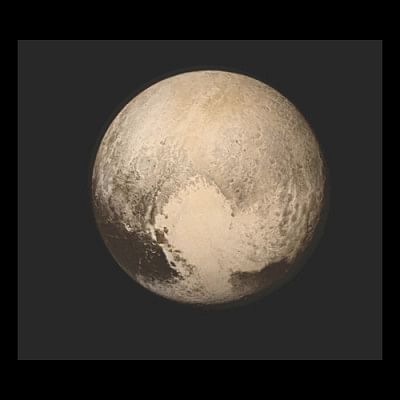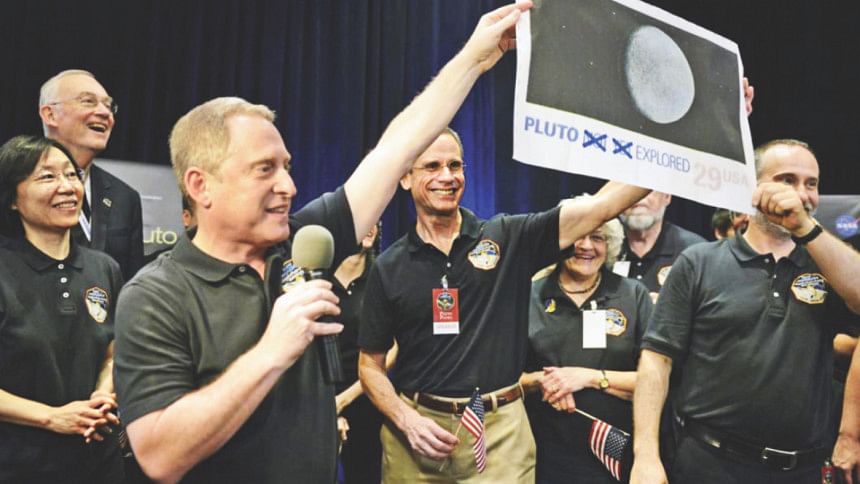Pluto Up Close

Scientists are receiving data that will offer the closest look ever of Pluto, after the unmanned Nasa spacecraft whizzed by the distant dwarf planet on Tuesday.
After a three-billion-mile journey that took nearly 10 years, the nuclear-powered New Horizons -- about the size of a baby grand piano -- snapped pictures of Pluto as it hurtled by on auto-pilot.
The photos will reveal details of Pluto never seen before in the history of space travel. The images are to be released by the US space agency, once they are downlinked from New Horizons.
"Sending back 'first-look' data to the team 'down under'," the New Horizons team tweeted yesterday morning, indicating its space antenna in Canberra, Australia was receiving information from the craft.
New Horizons is moving faster than any spacecraft ever built, at a speed of about 30,800 miles per hour.

Some 13 hours after the flyby, applause broke out in mission control at the Johns Hopkins Applied Physics Center outside the US capital Washington, as the spacecraft made its "phone-home" contact with Earth and all systems were reported to be intact.
"We have a healthy spacecraft," said mission operations manager Alice Bowman.
"We are outbound from Pluto."
The confirmation eased anxiety among scientists who were waiting all day to find out if the $700 million New Horizons survived the chaotic Kuiper Belt, the region beyond Neptune that Stern has described as a "shooting gallery" of cosmic debris.
Nasa had said there was a one in 10,000 chance that the spacecraft could be lost, and all it would take would be "a collision with a particle as small as a grain of rice."
The spacecraft passed 7,750 miles -- or about the distance from New York to Mumbai, India -- from Pluto's surface at 1149 GMT.
"It is truly amazing that humankind can go out and explore these worlds. And to see Pluto be revealed just before our eyes -- it is just fantastic," Bowman said.
New Horizons principal investigator Alan Stern said scientists can now look forward to a "16-month data waterfall" that will help scientists write whole new textbooks about Pluto.

"We have completed the initial reconnaissance of the solar system, an endeavour started under president (John F.) Kennedy more than 50 years ago, continuing today under President (Barack) Obama," Stern told reporters.
Obama cheered the mission on Twitter.
"Pluto just had its first visitor! Thanks @NASA - it's a great day for discovery and American leadership," the US president wrote.
Never before has a spacecraft ventured into the Kuiper Belt.
The spacecraft launched in 2006, the same year that Pluto was downgraded to "dwarf planet" status due to the celestial body's small size.
New Horizons is the first spacecraft to fly past Pluto and its seven scientific instruments aim to reveal up-close details of the surface, geology and atmosphere of Pluto and its five moons.
New Horizons "is looking at the temperature of #Pluto's night side. I wonder how cold it will be?," the craft's team tweeted after it zoomed by the dwarf planet.
Already, scientists have learned from New Horizons that Pluto is 12-18 miles larger than previously thought, with a radius of 736 miles.
Scientists have also confirmed the existence of a polar ice cap on Pluto and found nitrogen escaping from Pluto's atmosphere.
"This is truly a hallmark in human history," said the head of Nasa's Science Mission Directorate, John Grunsfeld.
Nasa Administrator Charles Bolden said the story of Pluto and New Horizons would be told for years to come.
"I know today we have inspired a whole new generation of explorers," said the former astronaut.
The spacecraft has enough fuel to carry on its exploration, and Stern said he plans to ask Nasa for funding to continue using New Horizons beyond its Pluto mission, in order to study more objects in the Kuiper Belt.
"We haven't seen anything yet. This is really just the beginning," said Grunsfeld.

 For all latest news, follow The Daily Star's Google News channel.
For all latest news, follow The Daily Star's Google News channel. 



Comments